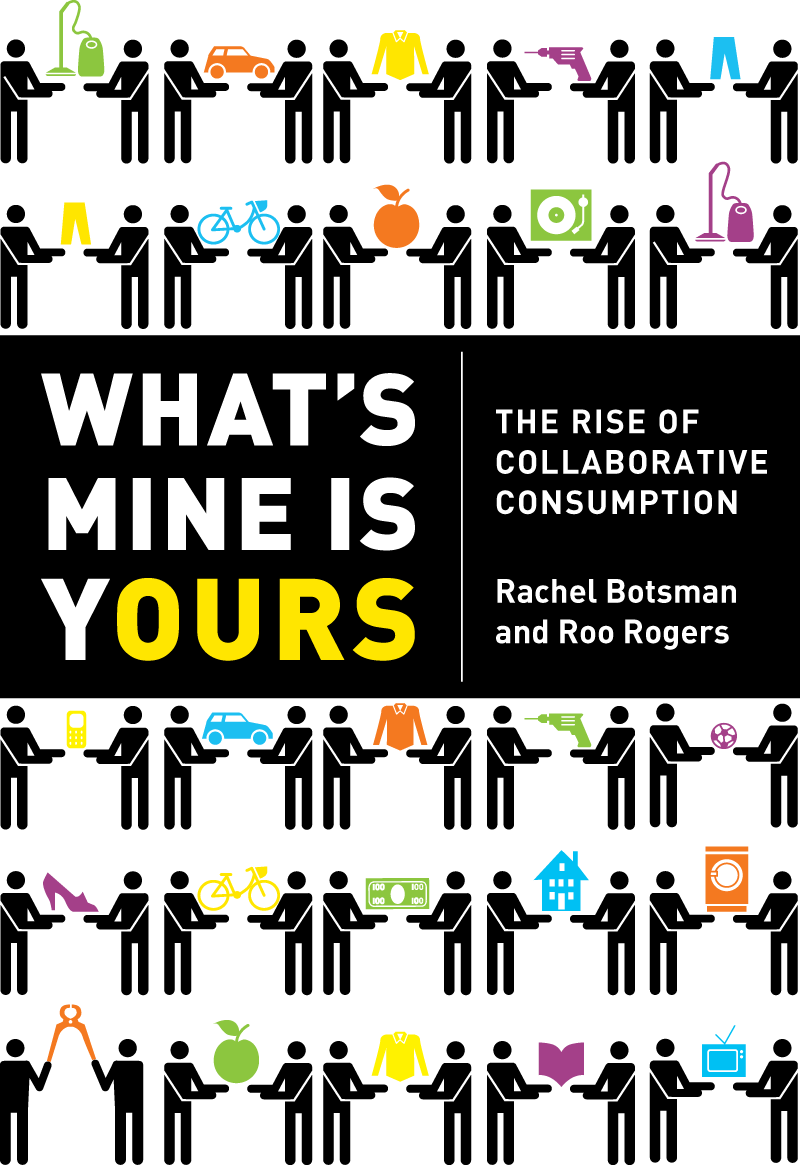The term “collaborative consumption” was coined way back in 1978, but the 2010 book What’s Mine is Yours: The Rise of Collaborative Consumption by Rachel Botsman and Ron Rogers is credited with popularizing the idea, mostly in a tech industry context. The book raises some interesting questions — Botsman’s insights into how exposing more of ourselves online actually builds trust rather than depletes it are especially revelatory, and the library-like digital tracking system set up to trace the book itself as it’s lent, borrowed, or swapped is pretty rad. Yet it takes a strongly market-oriented approach to the subject, perhaps giddy more at the prospect of entrepreneurship opportunities than the idea of pitching in to create an alternative social safety net during these rocky times via “sharing economies.”
As the collaborative notion broadens — now encompassing everything from multi-billion-dollar social networks based in Silicon Valley to a revival of artisanal handlebar mustaches in Brooklyn — I wanted to go to the source to get some SF-specific clarifications about the Australian authors’ views. The book has expanded, as books will these days, into a “movement hub” at www.collaborativeconsumption.com, and I was directed to Lauren Anderson, “Innovation Director of Collaborative Lab,” the book’s consultancy wing. (Because who could make any money just writing something nowadays?) Anderson’s pitch-perfect market-speak responses may limn the borders of sharing in our hardscrabble moment.
SFBG If you had to define the concept of collaborative consumption in a few words, what would you say? I’m having a devil of a time telling some of my friends about it without slipping into descriptions of classical anarchy, spiritual communes, and early homesteading techniques.
Lauren Anderson Collaborative consumption describes the resurgence of old-market behaviors like swapping, trading, renting, and sharing, which have been reinvented through realtime technologies and peer-to-peer networks to make sharing anything from cars to clothes to space to food to skills more efficient and affordable than buying new things directly. As we enter an age where we are valuing access over ownership, we are looking for more convenient ways to get the things we need rather than amassing a mountain of possessions that we use infrequently if at all!
SFBG It’s been frustrating in the Bay Area because we’re home to many of the major “sharing” websites and businesses — and we’re the home of some wonderful collaborative ideas both successful, like Two Degrees food sharing, and not, like Jumo social engagement — yet we seem painfully behind in terms of general collaborative on-the-ground projects that are already firmly established elsewhere. Despite being a center of bike activism, we’re only just finally getting our first official bike share program next month, and we have woefully few community gardens. Do you find that collaborative consumption takes off more profoundly in certain communities or civic environments rather than others?
LA San Francisco is certainly a global leader in collaborative consumption, and we have definitely seen many cities show leadership in embracing collaborative consumption businesses and projects. However, there is no definitive list of what is needed to make a city a “collaborative” one, and it really does depend on the needs and interests of the city. Bikesharing may be right for some cities where the landscape is conducive to getting around by bike, but may not be as practical in other cities.
What really makes a city collaborative is its appetite to try new things, and embrace new ways of thinking about how they go about daily life. Also a desire for openness and connection among neighbors and strangers. Leading collaborative consumption cities place a high value on a sense of community (specifically European cities like Berlin, Amsterdam, etc.).
SFBG As the idea of collaborative consumption matures, we’re starting to see some interesting contradictions arise. For instance, right now in SF there’s a lot of debate around Airbnb. Some think that because Airbnb operates outside of current tax laws and government regulations, it’s robbing the city of needed infrastructure revenue even as it’s allowing more people to visit the city, and in some cases could lead to tricky lawsuits due to its unregulated nature. There’s also now some debate going on about ZipCar — some people are discovering that people actually drive more now that cars are more available, and fear for both the environment and the diversity and resources of public transportation. Can you share your thoughts on such cases?
LA As collaborative consumption companies garner mainstream attention, it is expected that traditional industries will be challenged by these disruptors. We have actually noticed two polarized approaches to dealing with collaborative consumption — the first, as you describe, is where industry and government tries to introduce heavy legislation that make it hard to continue the activity in its current form, as in the case of Airbnb.
The second is where incumbents see the vast opportunities offered by collaborative consumption business models and look to diversify their revenue streams or in fact explore new models entirely. We have really seen auto manufacturers come to the table in this way, with partnerships with existing carsharing platforms (Ford+Zipcar, GM+RelayRides) as well as establishing their own (Daimler, BMW, Volkswagen).
This second approach is certainly more positive than the first, but as collaborative consumption companies mature, it’s reasonable to expect that they have a responsibility to make a contribution back to the cities they operate in the same way that businesses have done for many years.

